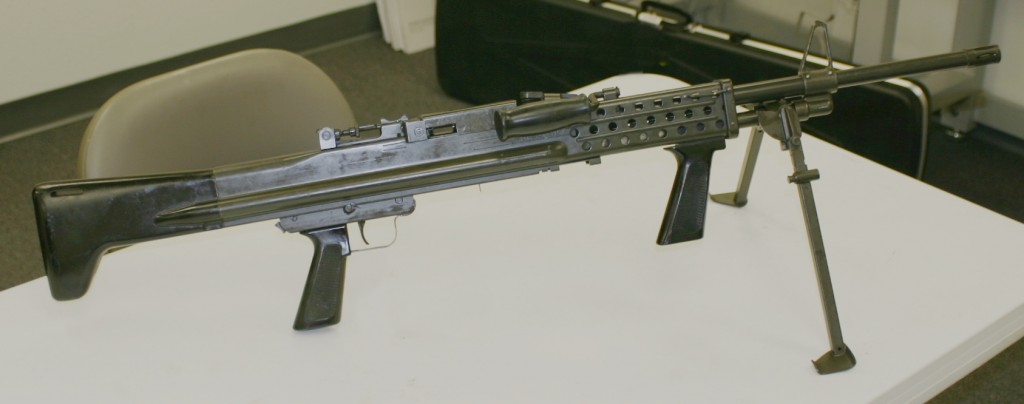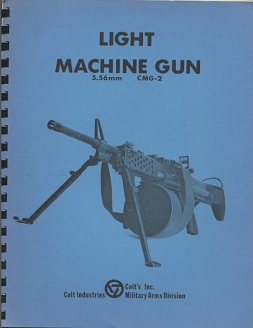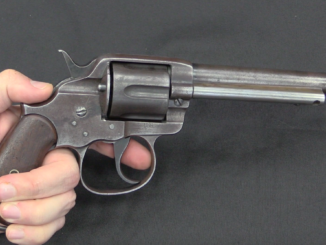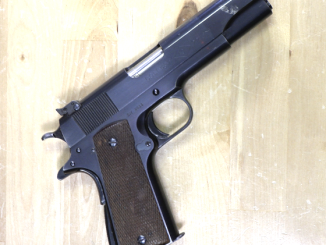During the 1960s, the Colt company was looking to help market the M-16 rifle to military forces by pairing it with a light machine gun. They were going after the exact same market segment as the Stoner 63 system. The first attempt at this was the Colt CMG-1, which had some limited parts commonality with the M16, but this was quickly replaced with the CMG-2.

The CMG-2 has a number of pretty interesting features, including a double-sided reversible firing pin (also seen on the Mendoza LMG) and an extractor designed as a permanent fixed feature of the bolt face. It is belt fed, and uses the same links as the Stoner 63, with a 150-round belt held in a drum fixed to the receiver of the gun. Another unusual attribute of the CMG-2 is its use of the rear pistol grip as a charging handle. To charge the gun, the pistol grip is pushed forward until the firing sear catches on the gas piston/bolt carrier. The grip is then pulled back, bringing the bolt carrier back with it into the cocked position. At that point the grip locks back into place and the gun is ready to fire.
Only a handful of CMG-2s were made by Colt before the project was dropped. The largest number went to the Navy SEALs for evaluation against the Stoner, in which they came in second place and were not adopted. Very few of these machine guns still exist, and we were fortunate to have the chance to disassemble one at the Institute of Military Technology to take a look at how they work:
Our understanding is that the long bolt travel and recoil buffer make the CMG-2 a very soft-shooting and controllable gun, although the drum that holds the belt is pretty awkward to reload. With more development, it could have been a pretty good weapon. We do also have a copy of an original Colt manual for it, which you can download here (this manual is also included on our Manual Archive DVD):





Wasn’t a copy og this made in Singapore???
CB in FL
Hi, Chris :
If you’re possibly referring to the first-generation Ultimax 100 5.56mm LMG from Chartered Industries Of Singapore ( CIS, now renamed Singapore Technologies Kinetics or STK ), we’re looking at two very different weapons that were developed to the same basic set of requirements at the time. The main design feature they had in common was the incorporation of a well-buffered long-recoil gas-operated system. However, the actual execution of this feature in the two designs was definitely not the same.
The Ultimax 100 was designed and developed by an in-house team led by a Scots engineer, A.C. “Sandy” McCormick, with considerable input from James Sullivan of Armalite fame.
Reportedly, the real downfall of the CMG-2 during the U.S. Army’s RFP and follow-up trials for a new-generation SAW was that it was designed for a special 68-grain 5.56mm bullet fired from a barrel with a rifling twist of one turn in 8.5 inches for optimum performance. The Army had already standardized on the 5.56mm M193 cartridge with a 55-grain bullet and wanted something that was fully compatible with the M193. Nobody wanted to have to incorporate a special round into the logistical train, and so the CMG-2 was shelved.
By the way, the CMG-2 was cocked in the same manner as the Czech vz.52 GPMG and British BESA tank MG.
The bolt cocking mechanism is exact as Czech VZ59 or UK59 (Universalny Kulomet),
Very interesting piece of machinery and truely those guns are hard to find around,you doing a great job ian by showing us those rare models of firearms..
The original CMG-1 used a direct gas impingement system similar to that of the M-16 rifle ; when Colt developed the more advanced CMG-2, they incorporated a self-regulating piston-driven system much like the one found on the M-60 GPMG.
As noted previously, the U.S. Army turned down the CMG-2 because of its special ammunition requirements. The original SAWS RFP gave rise to a whole new generation of really interesting designs — either directly or by proxy — such as the CMG-1, CMG-2, Stoner 63, FN Minimi ( later M-249 ), a heavy-barrel derivative of the M-16, an LMG version of the M-16A2, Maremont Universal Machine-Gun, Maremont XM-233, Philco-Ford XM-234, Ford Aerospace XM-248, Rodman Laboratories/Rock Island Arsenal XM-235, Heckler & Koch HK-23, IMI Negev, STK Ultimax 100, Steyr AUG/HBAR, CETME Ameli, Beretta 70/223 ( later adopted by the Italian Army as the AR-70/90 LMG ), Enfield LSW, and a Springfield Arsenal bullpup.
Some went on to achieve real commercial and military success, while others never got beyond the prototype stage. Interestingly, the constant convolutions of the SAWS programme engendered by the inability of the Department Of The Army to make up its mind what cartridge it really needed for the new SAW gave rise to a 6x45mm cartridge firing a 105-grain bullet at a muzzle velocity of 2445 ft/sec. with a muzzle energy of 1394 ft/lbs. The round was developed by Frankford Arsenal just in case a caliber other than 5.56mm was eventually adopted.
On a different note, this Frankford 6x45mm cartridge might be something to consider for Ian’s previous proposal to build the ideal personal battle rifle ( see “A Minor Controversy Over Cartridges” ).
Earl,
was the Frankford round loaded to the same overall length as the .223?
I did a quick check on Berger’s site, to get a feel for the ballistic coefficients of 105gr 6mm bullets.
To put it in its context, Ian would need a .22 bullet of around 90 grains to get the same BC, or a .30 bullet of around 165gr. The Frankford round looks like it was really well worked out.
incase anyone hasn’t read it yet, here’s a link to Geoffry Kolb’s article about bullets for long range (1200 yards).
http://www.border-barrels.com/articles/art1.htm
Hi, Keith :
Thanks for writing about this rather intriguing subject. As far as I know, the Frankford Arsenal 6 x 45mm cartridge was different from the 5.56 x 45mm ( .223″ ) cartridge. The overall length of the former was 65.54mm ( 2.580″ ) versus the latter’s 57.4mm ( 2.260″ ). Case lengths and diameters, as well as every other aspect of detailed diametrical and longitudinal dimensioning, was also different. I think the only reason why the somewhat misleading moniker of 45mm common case length ( falsely implying that the 6mm round was somehow based directly on the 5.56 x 45mm cartridge ) came about was because the 6mm case length was 45.01mm ( 1.772″ ) while the 5.56mm M193 case length was 44.70mm ( 1.760″ ). You can see what happened here with the obvious rounding-up / rounding-down of case length dimensions for identification purposes.
The Frankford 6 x 45mm cartridge was also referred to as the 6mm SAW round at the time. There is a very good website posting called http://www.lead-slinger.com/pdf/620CC.pdf that will give you all the in-depth technical details you will need for your own calculations and evaluation. The author posted this article in the course of proposing that what he calls the “6.2mm OCC” cartridge would be the ideal intermediate infantry round that provides the compact dimensions and light weight of the 5.56 x 45mm cartridge while largely retaining the stopping power of the 7.62 x 51mm NATO cartridge at typical battlefield ranges. The 6.2mm OCC is clearly a direct derivative of the original Frankford Arsenal 6 x 45mm round. I hope this will be of help to you.
On a broader note, contributors on this website may want to also read the same article in depth and provide some undoubtedly very useful insights that can only be of benefit to all. I have great respect for the depth and breadth of firearms knowledge that Keith, Ian, MG-42, Ruy Aballe and so many others have, and I think that more sharing of such knowledge can only make things that much better for all of us.
On this theme, has anyone heard from Hrachya recently? I have not seen any comments or postings from him for quite a while and I really hope he is alright.
What a fascinating gun.
I was intrigued by the locking cam helix and the associated free travel track being cut in the bolt shank rather than in the bolt carrier as it is in the AR15 and AR18, which would have allowed a simple u section race inside the receiver to prevent the bolt rotating when it is out of battery.
I’ve found (some of?) the patents for the gun.
Epacenet was down this morning, so I’ve joyously trudged through the USPTO site instead of spending the time digesting the info the patents
The 4 I’ve found so far;
The first two appear to cover the same ground with the whole gun:
US 3,791,256 February 12, 1974.
George F Curtis and Henry J Tatro Jr
US 3,756,119 September 4, 1973
George F Curtis and Henry J Tatro Jr
The Third is listed as a continuation of US 3,688,641, and covers the fire control group and pistol grip cocking handle
US 3,731,588 Curtis et al. May 8, 1973
US 3,688,641 September 5, 1972
George F Curtis and Henry J Tatro Jr
Again appears to cover the whole, gas piston operated gun.
I’ve not found any patents for the direct gas impingement version of the gun yet.
One of the more unusual guns which showed up while searching Colt patentas was the .221 “Scamp” machine pistol /PDW
http://worldwide.espacenet.com/publicationDetails/originalDocument?CC=US&NR=3774500A&KC=A&FT=D&ND=3&date=19731127&DB=EPODOC&locale=en_EP